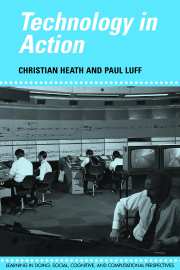Book contents
- Frontmatter
- Contents
- Preface
- 1 Technology and social action
- 2 Documents and professional practice: ‘bad’ organisational reasons for ‘good’ clinical records
- 3 Animating texts: the collaborative production of news stories
- 4 Team work: collaboration and control in London Underground line control rooms
- 5 The collaborative production of computer commands
- 6 ‘Interaction’ with computers in architecture
- 7 Reconfiguring the work space: media space and collaborative work
- 8 Organisational interaction and technological design
- References
- Index
5 - The collaborative production of computer commands
Published online by Cambridge University Press: 22 September 2009
- Frontmatter
- Contents
- Preface
- 1 Technology and social action
- 2 Documents and professional practice: ‘bad’ organisational reasons for ‘good’ clinical records
- 3 Animating texts: the collaborative production of news stories
- 4 Team work: collaboration and control in London Underground line control rooms
- 5 The collaborative production of computer commands
- 6 ‘Interaction’ with computers in architecture
- 7 Reconfiguring the work space: media space and collaborative work
- 8 Organisational interaction and technological design
- References
- Index
Summary
The division of labour, in its turn, implies interaction; for it consists not in the sheer difference of one man's kind of work from that of another, but in the fact that the different tasks and accomplishments are parts of a whole to whose product all, in some degree, contribute. And wholes, in the human social realm as in the rest of the biological and in the physical realm, have their essence in interaction. Work as social interaction is the central theme of sociological and social psychological study of work.
Hughes (1958)Introduction
In recent years, there has been a significant change in the nature of the technology which is used to support command and control in rail and rapid urban transport. Electromechanical displays, public announcement systems and mechanical signalling designed in the 1950s have been increasingly replaced by computer and telecommunication systems which can schedule trains automatically, set the appropriate signals and generate the relevant information for the travelling public. In the control room, rather than seeing the state of service through a set of lights on a fixed line diagram, augmented by screen displays as in the Bakerloo Line Control Room, the railway is viewed solely through visual display units and controlled through keyboards and mice. In this chapter, we wish to consider work and interaction in such a control room, one which is perhaps one of the most sophisticated, technologically, in the London area, if not the United Kingdom.
- Type
- Chapter
- Information
- Technology in Action , pp. 125 - 154Publisher: Cambridge University PressPrint publication year: 2000

